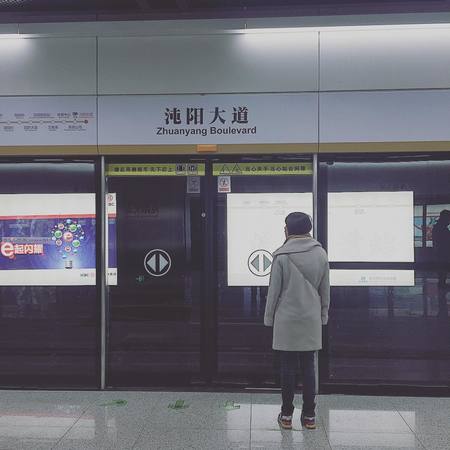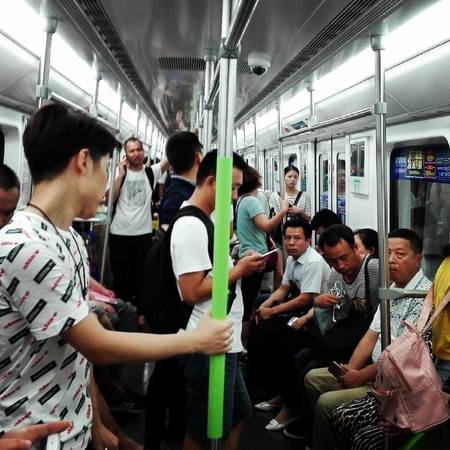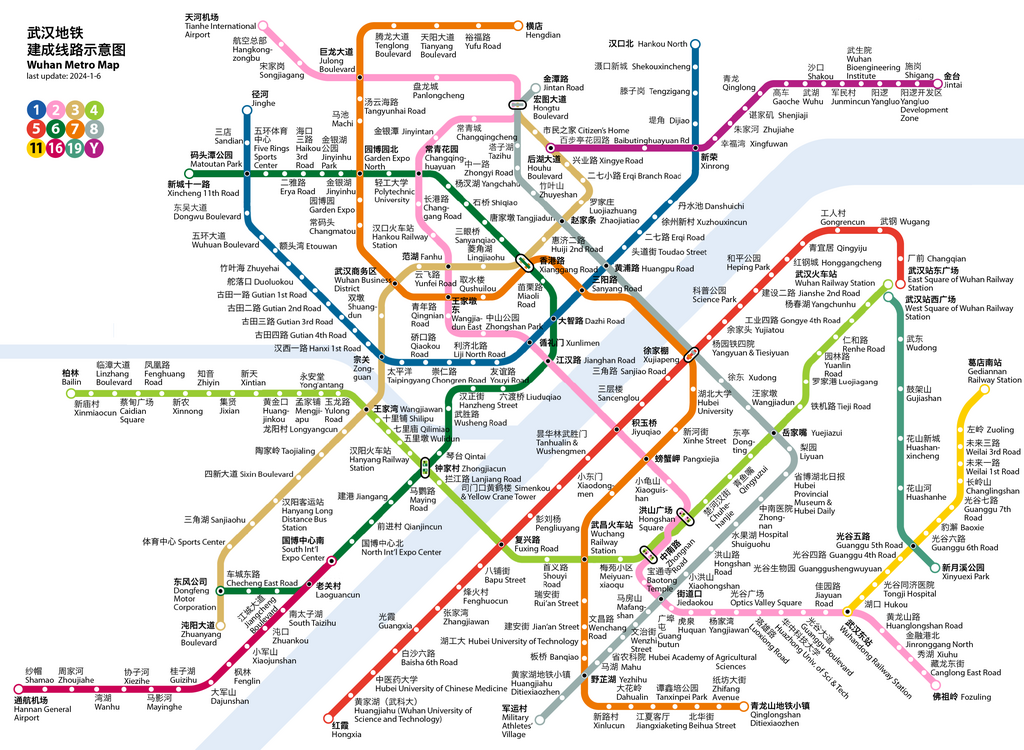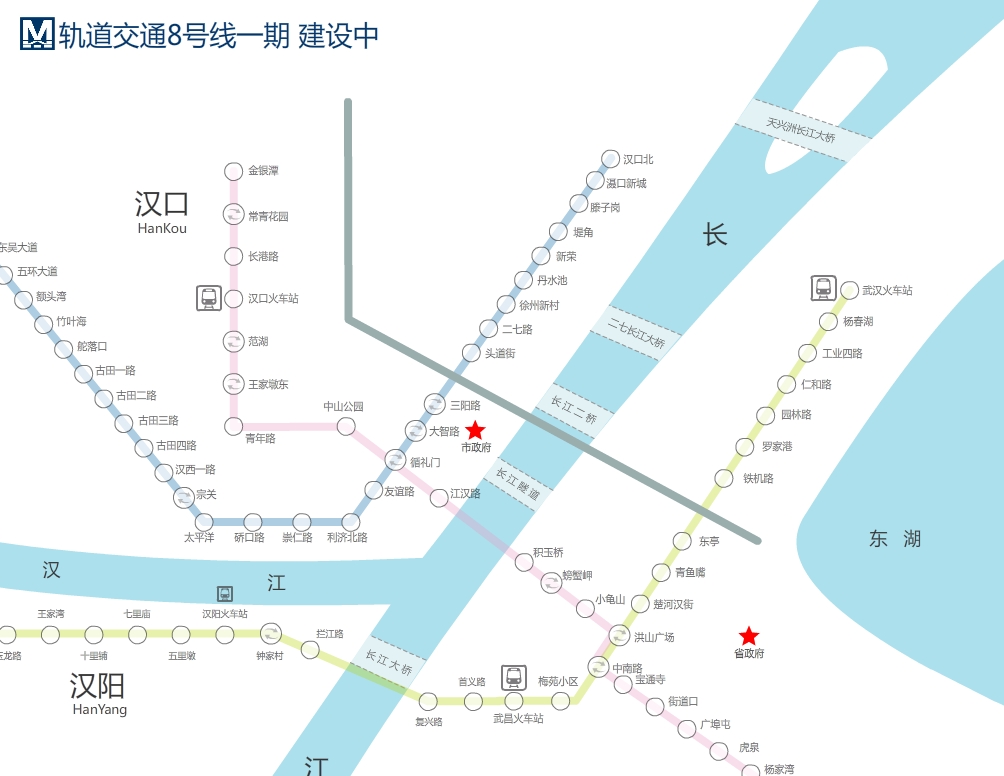Wuhan Metro is the rapid transit system of Wuhan, the capital of Hubei Province, China. As the metro started operation in 2004, Wuhan became the fifth city in China after Guangzhou, Shanghai, Tianjin and Beijing to have an urban subway system. It is operated by a communication based automated control system.
Wuhan Metro
Introduction
Currently, the network includes 4 operational lines, connecting 102 stations and 128.7 km long track length. Wuhan Metro Co. Ltd. operates the system. Every day, more than a million people use this as a means of transport.
Historical Background
Wuhan is constituted of three boroughs, namely Hankou, Wuchang and Hanyang. The metro system was conceived to improve the management of inter- and intra-borough traffic of the city.
- 1984: The planning started.
- Oct. 1999: National Planning Commission approved the Line 1, Phase 1 construction.
- Oct. 2000: Wuhan Rail Transit Co. Ltd. was established.
- Dec. 2000: Construction started for Line 1, Phase 1.
- 2002: Wuhan city government approved the long-term subway transport master plan.
- July 2004: Test run started for Line 1 from Zongguan - Huangpu Road.
- August 2004: Line 1 started full service.
- April 2007: Construction of Line 1, Phase 2 was approved.
- June 2006: Construction began for Line 4.
- Nov. 2006: Construction began for Line 2.
- May 2007: Establishment of Wuhan Metro Co. Ltd. to replace Wuhan Rail Transit Co. Ltd.
- July 2010: Line 1, Phase 2, between Dijiao and Dongwu Boulevard (except Zhuyehai), started full service.
- Sep. 2011: The design of Line 4, Phase 2 was approved.
- Dec. 2012: Line 2 started full service.
- Dec. 2013: Line 4, phase 1 started operation.
- May 2014: Line 1 Phase 3 to Hankou North Station started full operation.
- Sep. 2014: Zhuyehai station was opened.
- Dec. 2015: Line 3 started operation.
 Wuhan
Wuhan
Hours of Operation
The metro system operates between 06:00 AM to 10:30 PM on weekdays and 06:30 AM to 10:00 PM on weekends. However, slight variations of this timing can be noticed on individual lines. The minimum interval between trains is 1.5 minutes.
Lines and Stations
Currently, four lines, namely, Line 1, Line 2, Line 3 and Line 4 are in service. Many of the stations on these lines offer cross-platform interchange which makes transfer convenient for the passengers.
Line 1
Line 1 is a west-east line. It connects Hankou North station to Dongwu Boulevard station. The 34.6 km long line lies completely in the Hankou borough. There are 29 stations on it and all are elevated.
Every alternative train on this line reaches Hankou North Station; others end at Dijiao Station. It takes around 55 minutes to complete a full journey on this line. Transfer to Line 2 and Line 3 is possible from this line.
Main stations on this line are: Dongwu Boulevard, Wuhan Boulevard, Duoluokou, Gutian 1st Road, Hanxi 1st Road, Zongguan, Qiaokou Road, Xunlimen, Dazhi Road, Sanyang Road, Huangpu Road, Dijiao, Hankou NorthLine 2
Line 2 is a northwest-southeast line connecting Jinyintan to Optics Valley Square running under the Yangtze River. It is a 28-km long line with 21 stations. Some of the stations are underground, some are elevated. It connects important shopping areas and business districts of the city.
A complete journey on this line takes around 50 minutes. The transfer is possible to Line 1, 3 and 4. Main stations on this line are: Jinyintan, Changqing Huayuan, Hankou Railway Station, Fanhu, Wangjiadun East, Xunlimen, Jianghan Rd, Pangxiejia, Hongshan Square, Huquan, Optics Valley Square
Line 3
This is a north-south line running under the Han River. It starts from Hongtu Boulevard and ends at Zhuanyang Boulevard. It covers the Wuhan Economic- Technological Zone. The full track length is 33.2 km with 24 stations along it.
The whole journey takes around 55 minutes and transfer is possible to all the other three lines. Main stations on this line are: Zhuanyang Boulevard, Dongfeng Motor Corporation, Sports Center, Hanyang Long-Distance Bus Station, Wangjiawan, Zongguan, Wuhan Business District, Fanhu, Xianggang Road, Zhaojiatiao, Hongtu Boulevard
 Hongshan District
Hongshan District
Line 4
Line 4 is an east-west line joining Wuhan Railway Station to Huangjinkou Station. Wuhan, Hanyang and Wuchang railway stations are connected by this line. Main tourist spots and business districts also lie near this route. It is a 33.2-km long route with 28 stations.
It takes around an hour to complete the full journey on this track. Transfer to Line 2 and 3 is possible from this line. Important stations on this line are: Huangjinkou, Wangjiawan, Hanyang Railway Station, Zhongjiacun, Wuchang Railway Station, Zhongnan Road, Yuejiazui, Wuhan Railway Station
Future expansion
The city authority has the plan to build total 7 urban and 2 suburban lines by the end of 2017. Most of the lines will be underground. The total length of these lines is going to be 273.1 km. Among these lines constructions of Line 6, 7, 8 and 11 have started already. Line 2 will is also being extended further.
The long-term plan is to build a network of 25 lines, combining both urban and suburban lines. The total track length planned to achieve is 1045 km. When this plan is implemented, 55% of city’s traffic will be transported by Wuhan Metro.
Fares and Tickets
The fare for using Wuhan Metro is calculated based on distance. For the first 9 km, the fare is CNY 2. For a travel distance of 9 to 14 km, the price is CNY 3. The rule is CNY 1 for every 1.2 km traveled after the initial 9 km. To travel the maximum possible distance through these lines, it costs only CNY 6.
You can either buy single journey tokens or use your transportation card. Those who use Wuhan transportation card get a 10% discount on fares. Primary school children get a 30% discount on adult fare. People aged 65 years and disabled persons get to ride the metro free of cost.
The tokens are to be bought from the ticket vending machines and transportation cards are available at customer information centers. You need to scan the token or the card at the entry point and return the token at the exit gate.
Facilities and Services
The subway authority created multiple facilities and offer services that enhance the usability of the metro system manifold.
- Announcements are in Chinese and English.
- Stations are located near bus routes.
- There are special waiting rooms for women and also for mothers and children.
- The stations include libraries to encourage reading habits among the waiting passengers.

Rules
Passengers must take note of the following rules set by the metro authority:
- Eating, drinking and smoking are banned on board.
- You are not allowed to ride the trains with your bike.
- Pets are also not allowed inside the subways.
- Single journey tokens must be used within 3 hours from the time of purchase.
Tips
Following tips may help you to avoid unnecessary hazards while using the metro system:
- If the transportation card is damaged or not scanning properly, contact the customer office on the station.
- Each station has multiple exits. Make sure you are taking the right way towards your destination.
Media
Wuhan Metro Map in Wikipedia
Metro map of Wuhan
Map via www.whrt.gov.cnSee map full resolution. It may take a little bit to load.
Wuhan metro map
- Passengers/Day 35600
- Fares: access/exit gates
- 24h operation: No
- Air Conditioning: No
- Walk between platforms: No
- Driverless trains: No
- Screen Doors Platforms: No
- CNY 2
- Wuhan Metro Official Website
Help us
If you consider that the information we provide is wrong, not accurated, outdated, translation contains errors, and you would like to help us to improve the file...you can contact us here.
Feel free to contact us if you dont find the system you're looking for and we'll add it as soon as we can!
Thank you very much!








